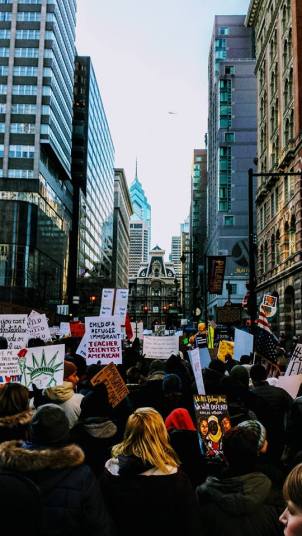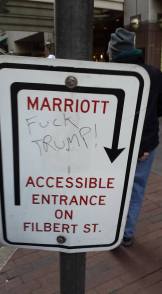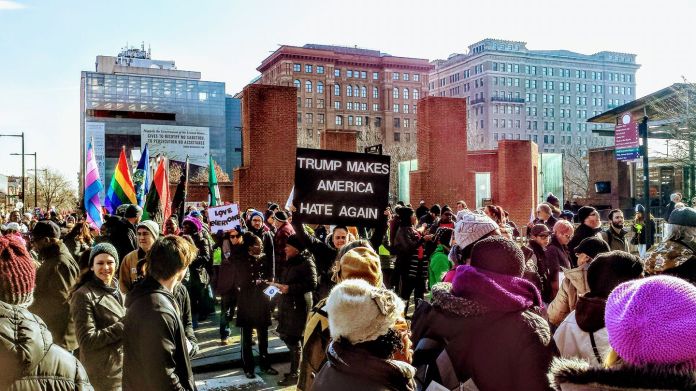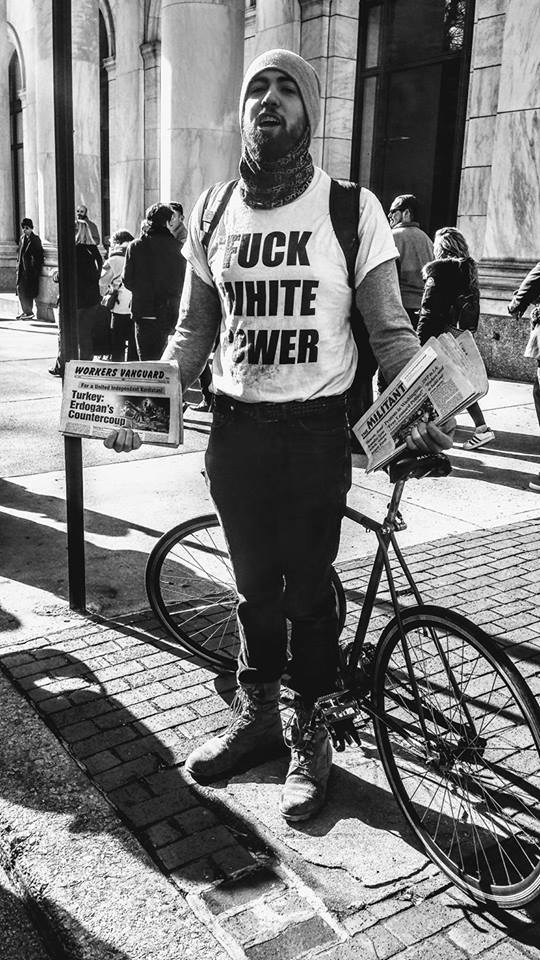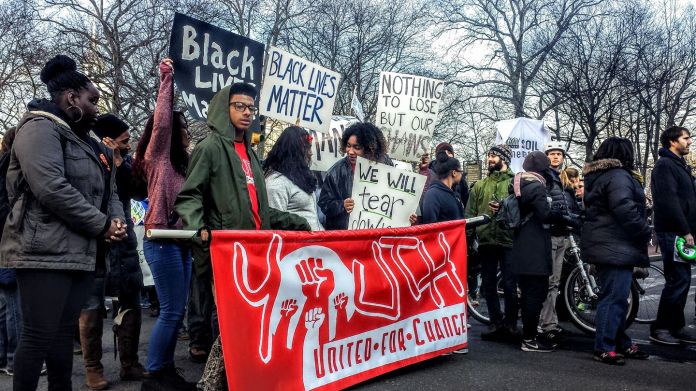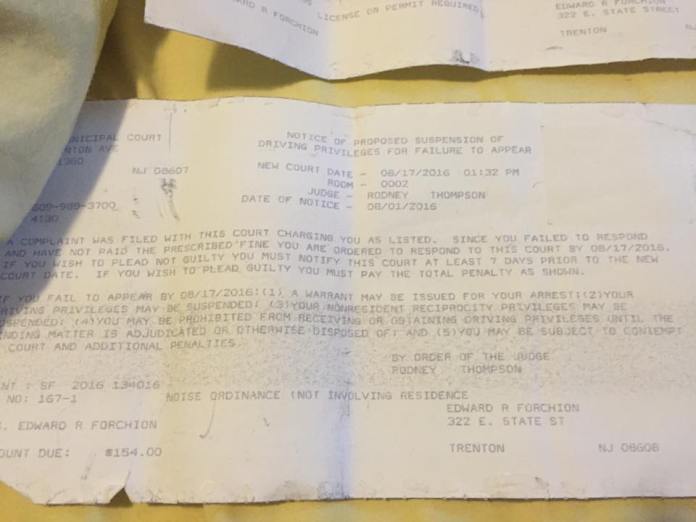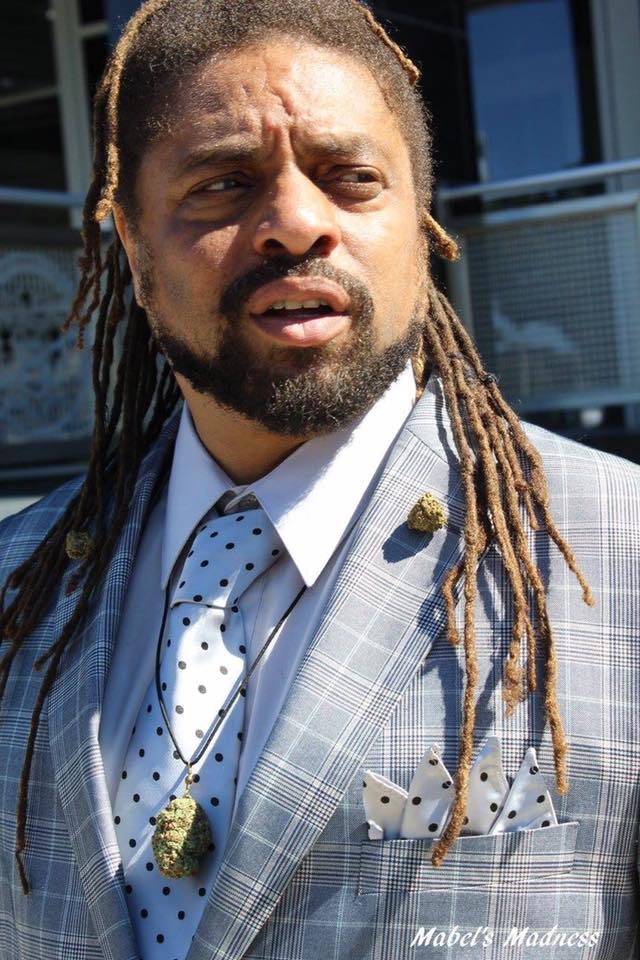The “First Counter-Inaugural” was launched by a national anti-war coalition in January 1969, in opposition to President Nixon’s policies of continuing the war in Vietnam. Workshops were held in D.C. on Saturday, January 18, 1969. On Sunday, 13,000 persons marched in the freezing weather, and then 10,000 attended the Counterinaugural Ball. On Monday, January 20, the inaugural parade was heavily guarded as thousands of demonstrators chanted from the side of the road. Afterward, several hundred confrontational youths flipped over trashcans and broke windows here and there. (Fred Halstead, Out Now!, 1978) The “Second Counter-Inaugural” in January 1973 against Nixon attracted 100,000 demonstrators, who received the support of liberal-dove politicians. Within the week Nixon formally signed the cease-fire agreement in Vietnam.
Hundreds of protesters poured into the streets minutes after Donald Trump was declared the 45th president of the US early Wednesday morning, November 9, 2016, blocking freeways, lighting fires and chanting, “Not our president” and “Fuck Trump.” The term “Not My President,” which was chanted across the nation by the end of the day, was borrowed from the Republicans who opposed Obama in 2008. #NotMyPresident was trending by the first day.
The protests are led mostly by Millennials who voted for Clinton, Sanders or other third party candidates, but they share their opposition against Trump. Young people immediately began protesting on college campuses and high schools in ways not seen since the 1960s (although, many young people were radicalized by BLM and the national college student protests in November 2015). When I marched in Philly on Wednesday, November 9, I noticed most of the people were very young (high school and college students mostly). Gender-wise, women overpopulated men by a good margin. The LGBTQ community had a powerful presence, and a transgender black student denounced rape culture. One chant listed the reasons for our anger: “racist, sexist, anti-gay, Donald Trump is KKK.” Our frustration over this nightmarish situation is represented by the upside-down American flags making appearances across the nation. The distressed flag made headlines a few weeks back when a veteran appeared with it at the #NODAPL camp in North Dakota. Perhaps we’re distressed because the police violence against nonviolent native Americans is about to be amplified to a nationwide level under a Trump Presidency. Talk about being distressed.
Most people who oppose the action claimed that the demonstrators were childish for refusing to accept the results, but this right-wing accusation misses the point. I speak for myself when I say that I have accepted the results of the election, but that doesn’t mean I have to accept the policies of an authoritarian figure. Donald Trump has made his positions very clear, and these positions are a direct attack on minorities and people of color. These protests indicate to the rest of the world that we are willing to start immediately in the fight against authoritarianism. Without the protests, the only message we would be sending is that we are complicit in a Trump presidency, or that we are too fearful and depressed to fight back. Rather than have closet sessions to discuss our fear of Trump, we are instead organizing in the streets to show Trump we won’t live in fear of him. Whatever regressive policies emerge in the next four years, at least Trump will know that we are willing to fight every single one through massive resistance. The Portland Mercury wrote: “On Tuesday, the world witnessed America elect a candidate who stood for sexual assault, xenophobia, racism, and isolationism. On Wednesday, the world saw thousands of Americans reject those values.”
The First Wave (Tuesday night, November 8/Wednesday morning, Nov. 9)
On November 9 the New York Times reported on the origins of the new wave of resistance, claiming the protests erupted “spontaneously among students who had gathered on the Berkeley campus to watch the results.” One Berkeley student screamed after the results:”We, the rational people, are a minority now.” Due to the time difference, the largest protests happened on the West Coast in CA. Over 200 students gathered and walked into Oakland city limits as the hashtags #Berkvote and #Berkprotest broke out. At UCLA’s Westwood campus, between 500 and 2,000 people rallied after midnight. Hundreds of students in Berkeley and Oakland marched in the streets during the pre-dawn hours on Wednesday. “This is the beginning of a movement,” an Oakland student said to the L.A. Times. During the march students spray painted anti-Trump profanity on buildings, “burned Trump effigies, smashed windows of the Oakland Tribune newsroom, and set tires, trash and newspaper stands on fire in Oakland and Berkeley,” reported CNN. “When our communities are under attack, what do we do? Stand up, fight back,” chanted demonstrators, using an already popular chant. Demonstrators were able to shut down Highway 24 around midnight for 20 minutes, but one individual was hit by a car and was taken to the hospital. Small protests broke out across the state in Santa Cruz, Irvine, San Francisco and San Diego.
Hundreds of young people also protested after the results in several other American cities. In Seattle, Washington, a hundred people blocked off an intersection late Tuesday night. In Portland, Oregon, hundreds of people blocked the road and delayed two light rail lines after midnight. The radical Portland students famously lit an American flag on fire, which was replicated by other cities. Protests broke out on both coasts. On the East Coast in PA, hundreds of University of Pittsburgh students took to the streets. High school students joined college students in the morning. At Berkeley High School, about 1,500 students — “half the entire student body” — walked out of class after first period began at 8 a.m. on Wednesday. Similar protests happened in Phoenix, Arizona; Boulder, Colorado; and Des Moines, Iowa.
This resembled the spontaneous launching of the Freedom Speech Movement on Berkeley campus in the fall of 1964, which marked the beginning of the counterculture youth movement. Several students were suspended for passing out literature for the civil rights movement, after the campus prevented students from doing so, and a protest was held on top of – and around – a police vehicle for over 30 hours . Leaders recognized the lacking freedom of speech within the civil rights movement and on college campuses. “Now the issue is free speech,” Berkeley student Mario Savio said back then. He described restricted speech as a symptom of anti-democratic jitters, and observed that the silence of both presidential candidates on the issue of Vietnam excluded students from the democratic process.
Today, in the midst of the BLM movement, campus students feel excluded from the democratic process because the victorious Republican Party stands in opposition to the majority of our views. Millennials by and large opposed Trump and his policies. Liberal campuses today are filled with young people who statistically support civil rights, LGBTQ rights, voting rights, women rights, environmental rights and marijuana legalization more than previous generational cohorts. Now young people are contemplating how many of these rights will be lost under a Trump administration. Rather than giving into fear, however, young people are uniting together and taking their anger to the streets.
The Second Wave (Wednesday, Nov. 9)
Dozens of cities erupted in protests on Wednesday evening, November 9, after millions of citizens stared at the election results in total disbelief. Unlike the first night of protests, when only a few hundred people protested, the following night of protests saw tens of thousands of people hit the streets. CNN claimed that protests occurred mostly in Democratic-based cities, but by the end of the week protests erupted in Republican geographical areas as well. According to ABC, an estimated 124 persons were arrested on Wednesday evening, along with a small amount of damage, vandalism and injuries in certain locations. But I counted at least 179 arrests and 11 citations that night across the country. According to the New York Times protests emerged in at least 25 cities.
New York City held the largest rally that night, with more than 10,000 people who marched in the street and burnt a Trump effigy. At least 65 persons were arrested in NYC, and the majority of them took place outside Trump Tower. Boston held a huge rally of nearly 10,000 demonstrators that night as well. Five demonstrators were arrested in Chicago for trying to shut down the Trump Tower (which opened in 2009), after blocking the Tower’s parking entrance. While thousands of people began marching, the Chicago police closed down the Wabash Avenue bridge to prevent anyone from getting too close to the Tower. Chicago police openly wore Trump buttons and taunted the demonstrators about Trump’s victory. Protesters pushed against the barricade, but were pushed back by officers on horseback. In two separate instances demonstrators blocked traffic on Lake Shore Drive.
One person was arrested outside the newly-opened Trump hotel in D.C. I marched in Philadelphia on Wednesday night with over 1,000 young people for three hours. Attempts were made to reach the highway, but Philly bicycle police blocked every entrance, and no arrests were made. One flag was burned, but another flag was carried upside down in a “distressed” fashion. Both tactics were popular throughout the country. Smaller protests took place in Providence, Rhode Island, and Portland, Maine.
Students burned an American flag on the campus of American University in Washington. In Seattle, thousands took to the streets for a protest called by Socialist Seattle City Councilwoman Kshama Sawant. Portland’s protests surpassed the previous night, this time reaching 2,000 persons, who blocked Interstate 5 twice and burnt American flags.Hundreds marched in Omaha, Nebraska, and two persons were arrested for obstruction and unlawful assembly.
Nearly 5,000 gathered in LA, where anti-Trump protesters shut down both sides of the 110 Freeway. Graffiti was sprayed upon the LA Times building and news vans in anti-Trump slogans. Later that night 29 people were arrested by the LAPD for shutting down the 101 Freeway.More than 7,000 persons marched in Oakland under the hashtag #Calexit, who set objects on fire and broke a few windows, leading to 30 arrests and 11 citations. The fire department put out around 40 fires caused by demonstrators setting dumpsters and trash pile fires. Democracy Now reported that Oakland police “deployed tear gas and flashbang grenades” against the crowd. Three Oakland officers were injured and two patrol cars were burned. Twelve other law enforcement agencies came to the aid of Oakland police. In Santa Ana, CA, according to Democracy Now, “police fired rubber bullets and pepper spray” at the crowd for taking over intersections. The crowd of more than 200 persons in Santa Ana damaged four police vehicles, and 10 demonstrators were arrested. About 300 students marched San Diego, but it dwindled to only 50 demonstrators that night, and police arrested 19 of them for failure to disperse.
The Trump protests have shockingly reached southern Red states. In Richmond, Virginia, hundreds chanted, “No Trump. No KKK. No fascist USA.” Demonstrators marched onto 1-95 South, resulting in the arrest of 10 people between the ages of 20 and 26. More than 300 persons marched in Austin, Texas, and they blocked a highway in the afternoon. A small crowd of 30 persons marched on the sidewalk in Charlotte, North Carolina, and two people were arrested for marching in the street. Smaller protests took place in Miami, Florida; Athens, Georgia; and New Orleans, Louisiana. In the city of Atlanta, Georgia, one person was arrested for walking in the street and disrupting traffic. At Western Kentucky University, pro-Trump and anti-Trump students clashed, leading to five arrests. Thus within 24 hours of being elected president, just under 200 people were arrested across the nation to protest Trump’s victory.
Donald Trump spoke unfavorably of the demonstrations by Thursday, November 10. In less than 48 hours after the election, Trump tweeted: “Just had a very open and successful presidential election. Now professional protesters, incited by the media, are protesting. Very unfair!” That same day former NYC Mayor Rudy Giuliani mocked the Millennial generation:“We’re bringing up a generation of spoiled crybabies.” Yet in the early morning of Friday, November 11, Trump sent out a second and more positive tweet: “Love the fact that the small groups of protesters last night have passion for our great country. We will all come together and be proud!”
The fact Trump criticized our first amendment right to free speech shows that we are justified in exorcising this right. In fact, the protests already achieved a significant goal by forcing Trump to change his position for the better. He no doubt sent out the second tweet after being criticized for failing to understand the emotional roller coaster many people were going through. Within two days young people held Trump more accountable for his rhetoric than the mainstream media did for over a year.
Thursday, November 10
“For the second night in a row,” young people across the nation protested Trump, reported the Root about the actions on Thursday. Associated Press wrote about the Thursday actions: “Around the country from New York to Chicago to California, in red states as well as blue, hundreds of demonstrators marched through streets, many for the third straight night though in somewhat smaller numbers.” The New York Times claimed protests erupted in at least 17 cities across the nation. The Huffington Post described Thursday’s gatherings as “generally smaller in scale and less intense than Wednesday’s.” Only about 40 arrests took place Thursday evening, in contrast to Wednesday’s display of 179 arrests.
Thousands in NYC protested outside Trump Tower again with one person arrested, and hundreds more protested the Trump Tower in Chicago. Around 2,000 persons marched in support of women’s rights in Philadelphia. About 500 persons marched in Louisville, Kentucky. More than 600 persons marched to the Ravens stadium in Baltimore, and along the way blocked some streets. Thousands marched in Minneapolis for the second night in a row, and they shut down Interstate-94 for nearly two hours. Socialist Alternative Minnesota organized 300 people to march in St. Paul. Thousands of people marched in Madison, Wisconsin’s capital, and in Milwaukee, the state’s most populous city.
In Denver, Colorado, demonstrators briefly shut down Interstate 25. Protests also took place in Austin, Texas; Dallas, Texas; San Marcos, Texas; and Salt Lake City, Utah. In Greensboro, North Carolina, two demonstrators were arrested for assault toward an officer and impeding traffic. According to ABC, at least three people were arrested in the Dallas march. In Houston that same night, police on horseback blocked a hundred demonstrators trying to march in the street, and resulted in five persons getting arrested. On Thursday morning, hundreds of Pittsburgh, CA, high school students walked out of class and marched in the street, resulting in three arrests.
In Oakland, demonstrators started small fires, broke a few windows and spray-painted anti-Trump remarks. Demonstrators shut down I-580, resulting in 11 arrests, including one person who had a Molotov cocktail. In L.A., a few hundred protesters halted traffic, threw bottles and spray-painted police vehicles. By 1 am the LAPD arrested multiple people.
That night tension grew in Portland, Oregon, where once again young people shut down the city streets, only this time with 4,000 people.”It was the third-straight night of protests in Portland,” wrote NPR. Police said people engaged in “criminal and dangerous behavior.” A small group of activists, unaffiliated with the organizers of the march, began to destroy cars at a dealership. Police claimed the small groups were “anarchists,” and proceeded to disperse the crowd by using “flash-bang devices” and tear gas. Apparently some people threw objects at the police, causing police to use “less lethal munitions,” such as pepper spray and rubber projectiles. Police arrested between 26 and 29 people that night. The protest gained the most fame that night after police declared it a “riot.” After the protest the Associated Press released an article titled, “Oregon Is Epicenter as Trump Protests Surge Across Nation.”
The Root wrote that only those with privilege could wait and see if Trump turned out to be a nice guy : “Whoever is willing to take the risk that Trump will fail to deliver on his promises is someone who can afford to take that risk and give him the benefit of the doubt. For the rest of us, all we see is prejudice being handed power with a strong mandate.” The article concluded: “We owe Donald Trump as much regard with respect to his presidency as he’s handed us to earn it: nothing.”
Everyone I spoke with said they felt better after the march than they did earlier that day. On November 10, Michael Moore spoke with Don Lemon on CNN about the NYC rally he joined that day. Lemon asked, “how did it feel to be there?” Moore replied: “It felt great.” He described the demonstrators marching toward him like being a “wave of humanity.”
The Trump protests can be seen as the first steps in forming a new coalition movement. Now that Clinton and Sanders people are both dissatisfied with Trump, the left has an opportunity to recreate itself in a way that actually includes the majority of Americans. This also serves as an opportune time to recruit for grassroots movements that will come under fire in Trumpland.
Bernie Sanders was quoted on the Trump protests in USA Today on November 14:”We have a First Amendment. People are angry. People are upset. And they want to express their point of view that they are very frightened, in very, very strong disagreement with Mr. Trump, who has made bigotry the cornerstone of his campaign. …”I think that people are saying, ‘Mr. Trump, we have come too far in this country fighting discrimination and bigotry. We’re not going back. And if you’re going to continue that effort, you’re going to have to take us on.’ …”
Friday, November 11:
Protests took place in at least 14 cities on Friday. Among the cities that were scenes of Friday protests were Los Angeles; New Haven, Connecticut; Chicago; Boston; Asheville, North Carolina; Nashville, Tennessee; Norfolk, VA; Washington; and Columbus, Ohio. There were also marches at schools in Denver and Omaha, Nebraska.
About a thousand people in NYC were hauled into “security pens” by police while protesting outside Trump Tower. At least 11 people were arrested, one of which was for someone who tried running past the security pens to Trump Tower. Atlanta, Georgia, held its third protest in a row on Friday night, where hundreds of people were blocked by police from entering a highway. Near Georgia’s state capital an American flag was burned. In Miami, Florida, hundreds gathered at a rally at Bayfront Park, but were joined by thousands more in the street as they blocked traffic on Biscayne Blvd. They shut down I-395 and continued marching until they marched onto I-95, successfully shutting down two highways. They marched back onto I-395 to return to the park, and no arrests were made. In Orlando, Fla., over 500 people protested peacefully.
More than 3,000 persons marched in L.A. on Friday night and early into Saturday morning, resulting in the arrests of 187 adults and eight juveniles. Disney Channel star Audrey Whitby was one of those arrested. The 195 arrests marked the highest amount of arrests at a single anti-Trump protest.
Portland police arrested 17 persons Friday night, and they used flash-bang grenades to disperse the crowd. CNN reported: “On Saturday, police began tweeting photos of protesters and asking people to identify them so arrests can be made.” Prior to 1 am on Saturday morning in Portland, a protest march on the Morrison Bridge ended when a male protester was shot by a bystander who drove by the march in his car. The protester was taken to the hospital and two 18-year old men were taken into custody for suspicion of the shooting.
The following day the Washington Post reported a total of 225 arrests across the nation up to that point. On Friday night alone, according to my calculations, there were at least 223 arrests. Wednesday, Thursday and Friday combined came out to 442 arrests nationwide.
Saturday, November 12:
Protests spread internationally by Saturday. CBS reported: “On Saturday, a group of Mexicans at statue representing independence in Mexico City expressed their concerns about a possible wave of deportations. One school teacher said it would add to the ‘unrest’ that’s already in Mexico.” About 300 people protested Trump’s election outside the U.S. Embassy near the landmark Brandenburg Gate in Berlin, Germany. In the U.S. protests emerged in 14 cities Saturday night. On November 12, the New York Times reported that protests erupted in 52 American cities since the election. At least 94 persons were arrested Saturday, for a four-day total of 536 arrests.
“In one of the largest anti-Trump demonstrations since his election on Tuesday,” the Times wrote, tens of thousands of people marched from Union Square to Trump Towers in NYC. Police estimated 25,000 persons, but other reports indicated there were upward of 100,000 persons. Two persons were detained for interfering with police process. By Monday morning, NYC’s Trump Tower was blocked off by pedestrians and the building was surrounded by sand trucks (similar to how Nixon surrounded the White House with buses during an anti-Vietnam protest in the 1970s). In Cincinnati anti-Trump demonstrators were joined by hundreds of people protesting a hung jury in the murder trial of a former University of Cincinnati police officer, who fatally shot a black motorist in July 2015. This showed the connection anti-Trump demonstrators could have with activist movements. Hundreds chanted “Black Lives Matter” in Miami, Florida, and they performed a sit-down in a major intersection. In Vermont over 200 persons protested at City Hall Park.
In L.A., over 8,000 persons marched through a quarter-mile-long tunnel en route to the Federal Building. Five persons were arrested in L.A. as the protest wound down early Sunday morning. Four adults were arrested on suspension of vandalism and one juvenile was arrested for battery on an officer. Indianapolis Metro Police Department tweeted on Saturday night that two officers were injured by protesters throwing rocks. This led Indianapolis police to make seven arrests that night, after protesters shut down I-80. Over a thousand people marched on the Las Vegas strip, and seven persons were arrested for blocking traffic on Las Vegas Blvd. In Chicago, where police set up a barricade outside of Trump Tower, demonstrators disrupted traffic in the Loop and two persons were detained.
Protests also took place in Washington; Dayton, Ohio; Cincinnati; Oklahoma City; Salt Lake City; Fresno, California; Phoenix and Temple, Arizona; Kansas City; Providence, Rhode Island; and Birmingham, Alabama. Cities like Philadelphia and Atlanta, which held large protests earlier in the week, were quiet on Saturday night, with only 30 persons coming out for the 4th straight night in Philly. A candlelight vigil was held in DC, and afterward demonstrators marched down Pennsylvania Avenue and disrupted traffic.
On Saturday in Portland, the city’s mayor, police officials and the main action group, Portland’s Resistance, pleaded for protesters not to go out on Saturday night. About 200 persons gathered in Portland around 6 pm. According to news reports, police announced vacate orders after protesters threw projectiles and road flares, and attacked a news crew. An anti-Trump message was also spray painted on a police vehicle. Shortly after midnight, police used peppery spray and tear gas. An estimated 71 persons were arrested that night for blocking intersections and standing in front of the light-rail trains. A public transit bus was used to transport those arrested, who ranged in age from 18-54. Five people arrested were issued criminal citations, and 67 others were booked in the local jail.
Sunday, November 13:
On Sunday there were 14 cities that protested across the nation. The Wall Street Journal wrote on November 13: “Though the largest protests have occurred in blue-state metropolises such as L.A., New York, Oakland and Chicago, there have been smaller demonstrations in red-state cities, including Dallas, Phoenix and Atlanta.”
Hundreds of high school and college students rallied in Jersey City, NJ, with the support of city council members. Just under a thousand demonstrators marched from City Hall to Independence Mall in Philly for the fifth straight day of protests in the city. Thousands protested in Manhattan against Trump’s immigration policies. About 100 Chicago demonstrators marched Sunday night to Trump Towers. More than a hundred persons marched in Muskegon, Michigan. Hundreds marched in Fort Lauderdale, Florida, but one woman was arrested for pouring water on a Trump supporter after heated arguments.
Protests also took place in Springfield, Massachusetts; Springfield, Montana; St. Louis, MO; Waikiki, Hawaii; Erie, Pennsylvania; Fort Lauderdale, Florida; and New Haven, Connecticut. About 1,500 persons rallied against Trump’s immigration policies outside City Hall on Sunday morning in Austin, Texas, and then marched on the Capitol. Later that night in Austin, about 150 persons marched on Congress Avenue and blocked traffic. A scuffle broke out between several pro-Trump and anti-Trump people, but no one was harmed, especially since a Muslim woman who voted for Hillary Clinton placed her body in front of the Trump supporter to prevent him from being harmed. Six people were arrested.
In Hollywood hundreds protested outside CNN’s headquarters, after blocking two lanes on Sunset Blvd. Hundreds of students and families with children marched in San Francisco from the Golden Gate Bridge to Ocean Beach, and by nightfall hundreds of people blocked traffic at an intersection. Another 800 persons marched in Sacramento. After several nights of radical protests in Oakland, thousands of people gathered peacefully on Sunday and “formed a human chain around the nearly 3.5-mile perimeter of Oakland’s Lake Merritt,” reported CBS, and they chanted:“We reject the president-elect.”
Willamette Week‘s opening liner on Sunday morning read: “Six consecutive nights of Portland protests against the presidency of Donald J. Trump have drawn thousands of outraged citizens, anarchists with baseball bats, a call by state Republicans to deploy the National Guard, a chiding from the Oregonian Editorial Board, and a shout-out from Dave Chappelle on Saturday Night Live.” On Sunday the protesters received support from a city official. City Commissioner-elect Chloe Eudaly marched in a family protest on Sunday afternoon, setting himself up to be an artificial channel between protesters and City Hall. Peace was kept throughout the Portland protest, although protesters were startled by fireworks that were set off. Therefore Sunday marked the least amount of arrests since the protests broke out, with only seven persons arrested. Yet, that leads to a total of 542 arrests in a five-day period.
Conclusion
The brief protests came and went. They died down after the first week of protests. I attended the last significant anti-Trump protest with a thousand people in Philly on November 19. No anti-Trump protests made it to December. Rather, the protests symbolized the state of disbelief felt by millions of Americans after the election, which galvanized young people to hit the streets and form the first anti-Trump coalition. Millennials – especially college-educated, women and POC – led the attack on the new administration, knowing full well this was the first stage.
The spontaneous protests led to concrete results. I already mentioned above that the protests accomplished such things as forcing Trump to send a retweet in apology of his first, nastier message. There were other concrete accomplishments, however, such as the organization Socialist Alternative, which made the call for anti-Trump protests, saw a dramatic increase of support within its ranks.
More importantly, the protests led to a call for a national Women’s March on Washington for a counter-inaugural rally on January 21, 2017. The Facebook page indicates the rally might be as large as the one in 1973, when 100,000 marched against the war. Yet the announcement of the march caused Trump’s Administration to prevent the organizers from receiving proper permits. This is historically rare for counter-inaugural protests, but not uncommon for D.C. in general. Permits were restricted by D.C. officials (Johnson Administration) during the October 1967 March on the Pentagon, when 100,000 people marched against the war and over 600 were arrested. In May 1970, Nixon surrounded the White House with district buses in case the 100,000 demonstrators broke down the gate. But the lack of permits allowed for the 2017 counter-inaugural protests possibly relays a message from the Trump Administration to the American people: dissent will not be tolerated.




